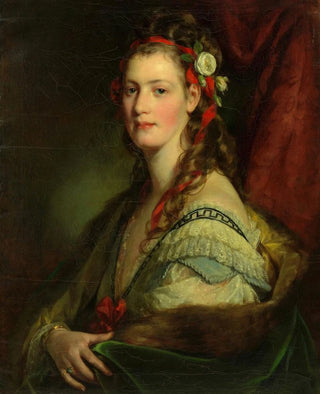Art print | Marie Paterno née Nemetschke plus tard Amerling ou Hoyos 4e épouse de l'artiste - Friedrich von Amerling


View from behind

Frame (optional)
Marie Paterno née Nemetschke, later Amerling or Hoyos, 4th wife of the artist – Friedrich von Amerling – Captivating introduction
Friedrich von Amerling's painting, a master of 19th-century portraiture, evokes a delicacy and emotional depth that transcend time. The artwork depicting Marie Paterno, née Nemetschke, embodies not only the physical beauty of her subject but also the complexity of human relationships within art. This representation, capturing the very essence of femininity, immerses us in a universe where light and shadow intertwine to create an intimate atmosphere. The artist, by choosing to paint his fourth wife, reveals a particular intimacy, a connection that goes beyond mere representation. This painting thus becomes a living testament to their union, marked by love and complicity.
Style and uniqueness of the work
Friedrich von Amerling's style is distinguished by his meticulous attention to detail and his ability to capture the soul of his models. In this piece, each brushstroke seems to tell a story, each nuance of color conveys an emotion. The chosen palette, soft and harmonious, emphasizes the delicate character of Marie Paterno, while highlighting the subtleties of her expression. The drapery of her dress, carefully crafted, testifies to the artist's technical skill. Amerling manages to create a perfect balance between realism and idealization, offering a vision that is both faithful and poetic of his wife. This work also stands out for its lighting, which plays a crucial role in highlighting Marie's features, illuminating her face with a soft and warm light.
The artist and his influence
Friedrich von Amerling, born in Vienna in 1803, is often regarded as one of the greatest portraitists of his time. His work is rooted in the realism movement, but he manages to infuse it with a romantic dimension unique to him. Trained in the ateliers of the greatest masters, Amerling developed a distinctive style, blending classical influences with personal innovations. His work profoundly impacted the Viennese artistic scene, inspiring many contemporary and future artists. The depiction of women in his work, often imbued with gentleness and dignity,

Matte finish

View from behind

Frame (optional)
Marie Paterno née Nemetschke, later Amerling or Hoyos, 4th wife of the artist – Friedrich von Amerling – Captivating introduction
Friedrich von Amerling's painting, a master of 19th-century portraiture, evokes a delicacy and emotional depth that transcend time. The artwork depicting Marie Paterno, née Nemetschke, embodies not only the physical beauty of her subject but also the complexity of human relationships within art. This representation, capturing the very essence of femininity, immerses us in a universe where light and shadow intertwine to create an intimate atmosphere. The artist, by choosing to paint his fourth wife, reveals a particular intimacy, a connection that goes beyond mere representation. This painting thus becomes a living testament to their union, marked by love and complicity.
Style and uniqueness of the work
Friedrich von Amerling's style is distinguished by his meticulous attention to detail and his ability to capture the soul of his models. In this piece, each brushstroke seems to tell a story, each nuance of color conveys an emotion. The chosen palette, soft and harmonious, emphasizes the delicate character of Marie Paterno, while highlighting the subtleties of her expression. The drapery of her dress, carefully crafted, testifies to the artist's technical skill. Amerling manages to create a perfect balance between realism and idealization, offering a vision that is both faithful and poetic of his wife. This work also stands out for its lighting, which plays a crucial role in highlighting Marie's features, illuminating her face with a soft and warm light.
The artist and his influence
Friedrich von Amerling, born in Vienna in 1803, is often regarded as one of the greatest portraitists of his time. His work is rooted in the realism movement, but he manages to infuse it with a romantic dimension unique to him. Trained in the ateliers of the greatest masters, Amerling developed a distinctive style, blending classical influences with personal innovations. His work profoundly impacted the Viennese artistic scene, inspiring many contemporary and future artists. The depiction of women in his work, often imbued with gentleness and dignity,






